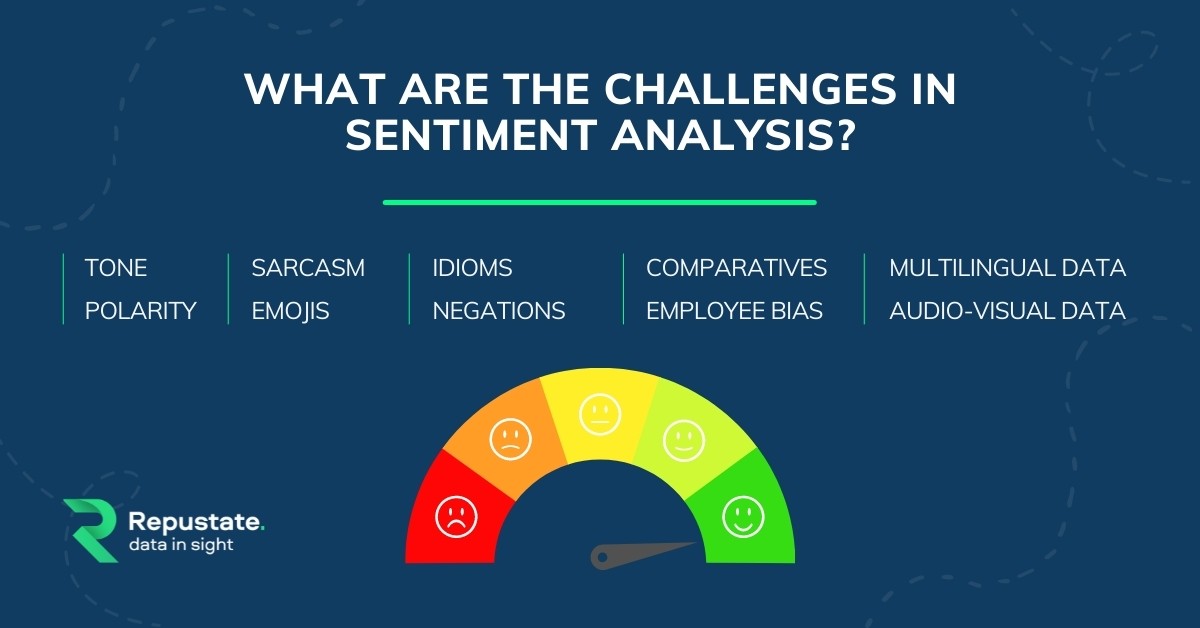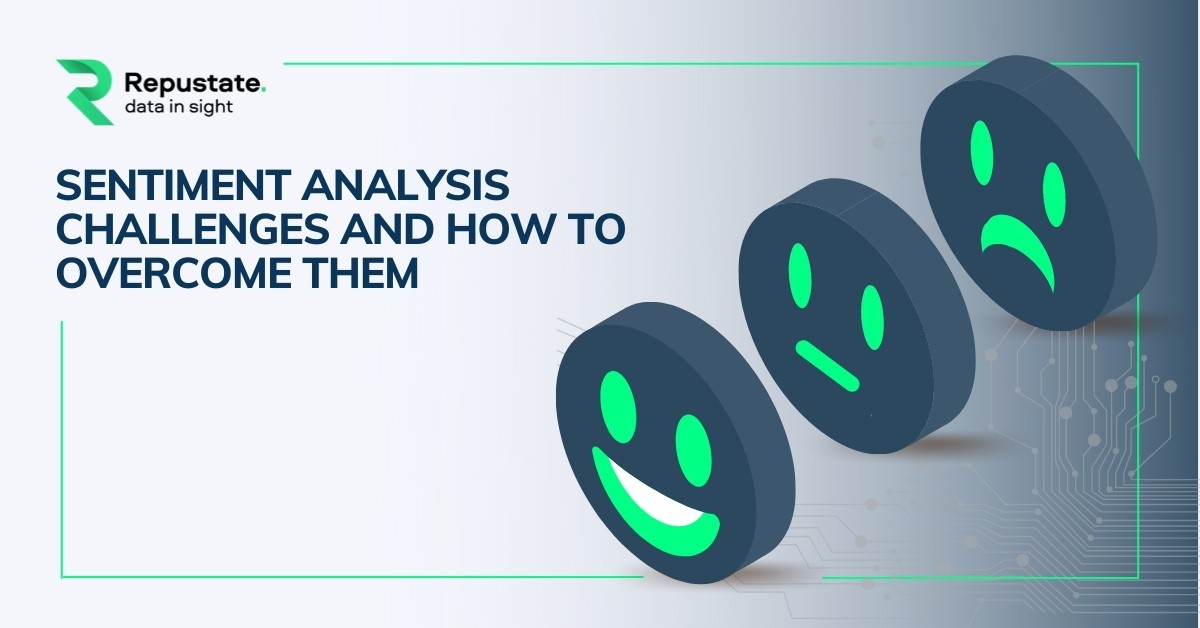Sentiment Analysis Challenges And How To Overcome Them
Here we are exploring the most complex natural language processing (NLP) issue: sentiment analysis challenges, and how to overcome them. Sentiment analysis has become an integral part of marketing. Not only can sentiment analysis accuracy help organizations establish how they are perceived, but it can also help them identify potential pitfalls in their marketing operations and branding content that can be dealt with on time. Though many companies face sentiment analysis challenges, these are not very difficult to overcome with the right solutions and collaboration partners. In this guide, we’ll break down some common challenges and all that’s needed to know to solve them.
What are the challenges in sentiment analysis?
When it comes to sentiment analysis challenges, there are quite a few things that companies struggle with in order to obtain sentiment analysis accuracy. Sentiment or emotion analysis can be difficult in natural language processing simply because machines have to be trained to analyze and understand emotions as a human brain does. This is in addition to understanding the nuances of different languages. As data science continues to evolve, sentiment analysis software is able to tackle these issues better. Here are the main roadblocks in analyzing sentiment.

1. Tone
Problem
Tone can be difficult to interpret verbally, and even more difficult to figure out in the written word. Things get even more complicated when one tries to analyze a massive volume of data that can contain both subjective and objective responses. Brands can face difficulties in finding subjective sentiments and properly analyzing them for their intended tone.
Solution
The basis of any good sentiment analysis software includes the ability to decipher subjective statements from objective ones and then find the right tone in it. For example: “The product is gorgeous but not at that price” is a subjective sentiment but with a tonality that says that the price makes the product less attractive. With a smart sentiment API, companies can decipher such nuances in tone, at scale.
See How A Tone Detector Algorithm Works
2. Polarity
Problem
Words such as “love” and “hate” are high on positive (+1) and negative (-1) scores in polarity. These are easy to understand. But there are in-between conjugations of words such as “not so bad” that can mean “average” and hence lie in mid-polarity (-75). Sometimes phrases like these get left out, which dilutes the sentiment score.
Solution
Sentiment analysis tools can easily figure out these mid-polar phrases and words in order to give a holistic view of a comment. In this context, a topic-based sentiment analysis can give a well-rounded analysis, but with aspect-based sentiment analysis, one can get an in-depth view of many aspects within a comment.
3. Sarcasm
Problem
People use irony and sarcasm in casual conversations and memes on social media. The act of expressing negative sentiment using backhanded compliments can make it difficult for sentiment analysis tools to detect the true context of what the response is actually implying. This can often result in a higher volume of “positive” feedback that is actually negative.
Solution
A top-tier sentiment analysis API will be able to detect the context of the language used and everything else involved in creating actual sentiment when a person posts something. For this, the language dataset on which the sentiment analysis model has been trained, needs to not only be precise but also massive.
Research to Refer:
Types of Sarcasm | Multimodal sarcasm detection | Social media sentiment analysis
4. Emojis
Problem
The problem with social media content that is text-based, like Twitter, is that they are inundated with emojis. NLP tasks are trained to be language specific. While they can extract text from even images, emojis are a language in itself. Most emotion analysis solutions treat emojis like special characters that are removed from the data during the process of sentiment mining. But doing so means that companies will not receive holistic insights from the data.
Solution
To meet sentiment analysis challenges like this, a company needs to employ an emotion analyzer tool that can decode the language in emojis and not club them with special characters like commas, spaces or full stops. This in itself is a very advanced application where models like Repustate’s are trained specifically for it. Data scientists first analyze whether people use emojis more frequently in positive or negative events, and then train the models to learn the correlation between words and different emojis.
5. Idioms
Problem
Machine learning programs don’t necessarily understand a figure of speech. For example, an idiom like “not my cup of tea” will boggle the algorithm because it understands things in the literal sense. Hence, when an idiom is used in a comment or a review, the sentence can be misconstrued by the algorithm or even ignored. To overcome this problem a sentiment analysis platform needs to be trained in understanding idioms. When it comes to multiple languages, this problem becomes manifold.
Learn more about sentiment analysis in reviews.
Solution
The only way this challenge can be met with sentiment analysis accuracy is if the neural networks in an emotion mining API are trained to understand and interpret idioms. Idioms are mapped according to nouns that denote emotions like anger, joy, determination, success, etc. and then the models are trained accordingly. Suffice to say, only then can a tool for analyzing sentiment give accurate insights from such text.
6. Negations
Problem
Negations, given by words such as not, never, cannot, were not, etc. can confuse the ML model. For example, a machine algorithm needs to understand that a phrase that says, “I can’t not go to my class reunion”, means that the person intends to go to the class reunion.
Solution
A sentiment analysis platform has to be trained to understand that double negatives outweigh each other and turn a sentence into a positive. This can only be done when there is enough corpus to train the algorithm and it has the maximum number of negation words possible to make the optimum number of permutations and combinations.
7. Comparative sentences
Problem
Comparative sentences can be tricky because they may not always give an opinion. Much of it has to be deduced. For example, when somebody writes, “the Galaxy S20 is larger than the Apple iphone12”, the sentence does not mention any negative or positive emotion but rather states a relative ordering in terms of the size of the two phones.
Solution
Sentiment analysis accuracy can be achieved in this case when a sentiment model can compare the extent to which an entity has one property to a greater or lesser extent than another property. And then tie that to a negative or positive sentiment. This is not an issue of simply having a corpus of negative or positive sentiment-specific words, but in training the artificial intelligence machine to actually pull together information from its knowledge graph and analyze the relationship between entities, words, and emotions.
8. Employee bias
Problem
Employee feedback is valuable when it comes to shaping company culture, improving sales tactics, and reducing employee turnover. Many companies, though, find themselves struggling to parse information because of biases. These can be either from the employee, or from the perspective of the surveyor who may not take the responses of an ex-employee seriously.
Solution
Sentiment analysis tools can help you understand employee sentiments from surveys and online employment review websites like Glassdoor, more thoroughly. Text analytics can help read the actual sentiment behind employee feedback and analyze emotional responses to determine bias, and eliminate human errors.
9. Multilingual sentiment analysis
Problem
Multilingual sentiment analysis constitutes all the problems listed above get compounded when a mix of languages are thrown in. Each language needs a unique part-of-speech tagger, lemmatizer, and grammatical constructs to understand negations. Because each language is unique, it cannot be translated into a base language like say, English, to extract insights. A simple example being, if an idiom “like a fish takes to water” is translated into say, German, the idiom would have lost its meaning.
Solution
The only way these sentiment analysis challenges for multilingual data can be overcome is the hard way. This means that the sentiment analysis model needs to have a uniquely trained platform and named entity recognition model for each language like Repustate has. There is no shortcut to this because the model needs to be trained in each language manually by data scientists. This is a time-consuming process that needs precision and diligence. But the results are worth it because it will give you the highest sentiment analysis accuracy scores as possible.
10. Audio-visual data
Problem
Videos are not the same as text data. The challenge is not only that videos need to be transcribed but that they may have captions that need to be analyzed for brand logos. Social media videos also come with comments in addition to the video data.
Solution
A sentiment analyzer can give accurate insights from your data if it extracts information from video content as easily as from text data. For this, it needs to have a video content analysis model that can break down videos to extract entities and glean insights about customer opinion, product insights, and brand logos.
Discover More: Top 10 Sentiment Analysis Features.
Why do companies depend on sentiment analysis?
Companies depend on sentiment analysis to gain a deeper understanding of the consumer mindset. This translates into a better return on investment from more profitable marketing strategies. Sentiment analysis insights gathered from different sources lead to improved product features, pricing, store locations, customer experience, and overall employee satisfaction. Below are the main areas through which sentiment analysis helps businesses.
- Patient voice
- Social media listening
- Business intelligence
- Brand insights
- Reputation management
- Competitive analysis
- Opinion mining
- Voice of the Employee (VoE)
- Voice of the Customer (VoC)
Explore More About These Sentiment Analysis Applications.
How brands improve sentiment analysis accuracy
Every challenge we’ve covered can be smartly tackled through the use of a strong sentiment analysis API. Repustate’s software can even analyze real-time sentiment and report on everything related to customer sentiment, from comment tone to phrases with multipolarity to employee feedback. This is done through a wide range of AI-based techniques such as text analytics, natural language processing, and named entity recognition tasks. Repustate sentiment analysis platform understands 23 languages natively, which means wherever your business is, and whoever your customers are, you can get deep-dives in consumer insights, regardless.
Discover more about Sentiment analysis use cases.
 Home
Home
 Jun 11, 2021
Jun 11, 2021

 Jeremy Wemple
Jeremy Wemple
 Dr. Ayman Abdelazem
Dr. Ayman Abdelazem
 Dr. Salah Alnajem, PhD
Dr. Salah Alnajem, PhD
 David Allen
David Allen

 Repustate Team
Repustate Team

